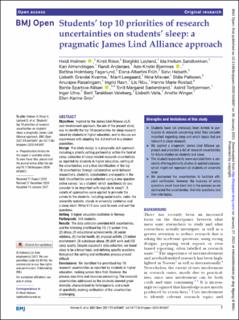Students’ top 10 priorities of research uncertainties on students’ sleep: a pragmatic James Lind Alliance approach
Holmen, Heidi; Riiser, Kirsti; Løyland, Borghild; Sandbekken, Ida Hellum; Almendingen, Kari; Andenæs, Randi; Bjørnnes, Ann Kristin; Holmberg Fagerlund, Bettina; Albertini Früh, Elena; Helseth, Sølvi; Kvarme, Lisbeth Gravdal; Leegaard, Marit; Misvær, Nina; Pallesen, Ståle; Rasalingam, Anurajee; Ravn, Ingrid Helen; Ribu, Lis; Rostad, Hanne Marie; Sparboe-Nilsen, Bente; Sæterstrand, Torill Margaret; Torbjørnsen, Astrid; Utne, Inger; Valeberg, Berit Taraldsen; Valla, Lisbeth; Winger, Anette; Grov, Ellen Karine
Peer reviewed, Journal article
Published version

View/
Date
2021Metadata
Show full item recordCollections
Original version
Holmen, H., Riiser, K., Løyland, B., Sandbekken, I. H., Almendingen, K., Andenæs, R., Bjørnnes, A. K., Fagerlund, B. H., Früh, E. A., Helseth, S., Kvarme, L. G., Leegaard, M., Misvær, N., Pallesen, S., Rasalingam, A., Ravn, I., Ribu, L., Rostad, H. M., Sparboe-Nilsen, B., Sæterstrand, T. M., Torbjørnsen, A., Utne, I., Valeberg, B. T., Valla, L., Winger, A. & Grov, E. K. (2021). Students’ top 10 priorities of research uncertainties on students’ sleep: a pragmatic James Lind Alliance approach. BMJ open, 11, e043697. https://doi.org/10.1136/bmjopen-2020-043697Abstract
Objectives: Inspired by the James Lind Alliance (JLA) user involvement approach, the aim of the present study was to identify the top 10 uncertainties for sleep research raised by students in higher education, and to discuss our experiences with adapting the JLA method to a student population.
Design: The study design is a pragmatic JLA approach, including a priority setting partnership within the field of sleep, collection of sleep-related research uncertainties as reported by students in higher education, sorting of the uncertainties and a final identification of the top 10 uncertainties through collaborative work between researchers, students, stakeholders and experts in the field. Uncertainties were collected using a one-question online survey: ‘as a student, which question(s) do you consider to be important with regards to sleep?’. A variety of approaches were applied to promote the survey to the students, including social media, radio, the university website, stands in university cafeterias and a sleep stunt. NVivo V.12 was used to code and sort the questions.
Setting: A higher education institution in Norway.
Participants: 555 students.
Results: The data collection provided 608 uncertainties, and the following prioritised top 10: (1) screen time, (2) stress, (3) educational achievements, (4) social relations, (5) mental health, (6) physical activity, (7) indoor environment, (8) substance abuse, (9) shift work and (10) sleep quality. Despite successful data collection, we found sleep to be a broad topic, and defining specific questions throughout the sorting and verification process proved difficult.
Conclusions: We identified the prioritised top 10 research uncertainties as reported by students in higher education, ranking screen time first. However, the process was time and resource consuming. The research uncertainties addressed by the students showed great diversity, characterised by heterogeneity and a lack of specificity, making verification of the uncertainties challenging.
